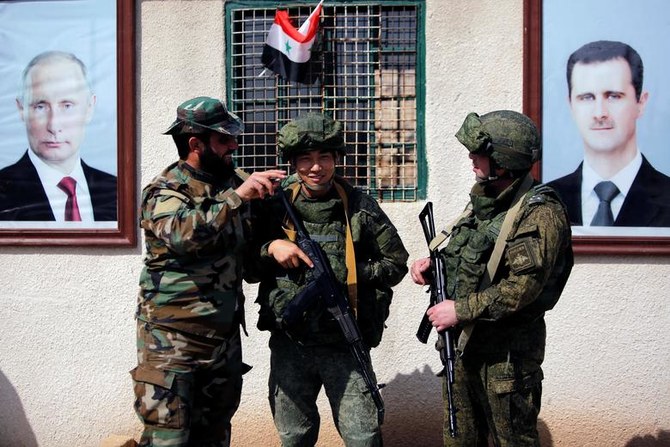Russia’s Syria withdrawal a boon for Iran’s regional project

https://arab.news/yt7fe
The echoes of the Russian-Ukrainian war, which is less than four months old, have reached our region. Our talk is not about units or militias affiliated with Tehran joining the fight there. Rather, we are talking about geopolitics, as well as the void we have begun to notice as a result of the gradual military retreat and withdrawal of Russia from Syria, with the Iranian presence filling this void.
Russia moved into the region in the shadow of the American withdrawal as it sought to achieve its interests. This led to Moscow improving its trade and investment balance, besides using the port of Tartus and playing an important role in the Middle East.
Russia’s military presence in Syria — to support the Damascus regime — was considered a counterbalance and check on Iran, even though it is an ally of the Iranians there. Its presence has also become a reason for the regional acceptance of the spread of Iran’s militias in Syria.
However, the theory of the foreign balance inside Syria is on the verge of disruption. In recent weeks, there have been reports of Russian troops leaving, possibly to the front line in Ukraine. We will likely see further Russian withdrawals, creating more space for the Iranians. The Russian withdrawal from Syria could end up as a repeat of America’s withdrawal from Iraq. This might mean the Iraqi scenario — with its sectarian war, demographic changes, armed terrorist militias, killings and displacement — is replicated in Syria.
Things may even go further than that because Tehran has a terrorist project and hidden agendas. The outbreak of the Syrian revolution gave Iran’s Quds Force justification to intervene in Iraq and Syria by working with Shiite militias in Iraq, the Syrian regime and Hezbollah, which doubled its influence. Since 2014, Iran has taken a series of steps to strengthen its position in Syria and Lebanon, especially its military presence, as well as the status of its proxies like Hezbollah.
Therefore, Iran has adopted a policy of building strategic axes, including working to build a land corridor linking Tehran with Syria and Lebanon via Iraq. To give itself a foothold on the Mediterranean coast, Iran sought to use the Syrian sea port in Latakia. This corridor strengthens the Shiite environment, as well as allowing Iran to supply Hezbollah’s military. It allows Tehran to appear before the Sunni world as an extended Shiite power in the region. It controls more than one Arab country and has combat experience it can transfer to any area of influence that is of interest.
Iran has adopted a policy of building strategic axes, including working to build a land corridor linking Tehran with Syria and Lebanon via Iraq.
Dr. Hamdan Al-Shehri
Iran’s construction of a land route to facilitate the movement of military forces and weapons through Iraq to Syria and Lebanon will, of course, be under Iranian control and influence via the Islamic Revolutionary Guard Corps and armed Shiite militias. The aim is to diversify its methods of moving forces and weapons depending on the conditions on the ground.
Tehran has never announced its intention to build this corridor, as it realizes that the use of this land route has advantages and disadvantages related to its exposure to attacks by the US, Israel and the Sunni elements opposed to it. But the Al-Qaim-Al-Bukamal border crossing between Syria and Iraq has been opened.
Several reports indicate that convoys of the IRGC and the Iraqi Popular Mobilization Units entered Syrian territory through the city of Al-Bukamal and headed to Deir Ezzor governorate in the east. This means that Iran is already targeting the land link to Damascus for military purposes, which enhances its ability to maintain its military presence in Syria. Certainly, US President Donald Trump’s December 2018 decision to withdraw troops from Syria reinforced Iran’s ambitions to complete its land corridor.
Tehran wants to strengthen its long-term position in Syria, whether it is ruled by Bashar Assad or someone else. The Iranian project in Syria is not linked to the duration of the civil war, but rather to the consolidation of its own long-term interests in the region. The Russian withdrawal will give Tehran the greatest motivation to hurriedly implement its projects to control the region and occupy the largest geographical area in it. As usual, it will use its terrorist militias and will play functional roles for global powers in the region.
Thus, the strategic importance of this route lies in it being a corridor of influence, a corridor of arms trafficking and weapons smuggling to its proxies, and part of a trade route that brings together the various militias supported by Iran, as well as being an outlet for them to the Mediterranean.
Beyond this, we see the terrorist militias affiliated with Tehran, led by Hezbollah, making successive and repeated attempts to smuggle drugs into Jordan. There was a clash between Hezbollah-linked smugglers and the Jordanian army recently, which resulted in four of the smugglers being killed.
The purpose of this is to destabilize Amman and work to weaken it, with the ultimate goal of making it the fifth Arab capital occupied by Tehran. This would make it easier for Iran and its militias to threaten Saudi Arabia from the north.
Arab national security is needed today, not only to stop the expansion of the Iranian terrorist project, but to counter and confront it and liberate the occupied Arab countries. This is the only way to stop the terrorism of Tehran and its militias and to block their way forward.
- Dr. Hamdan Al-Shehri is a political analyst and international relations scholar. Twitter: @drhamsher7










































